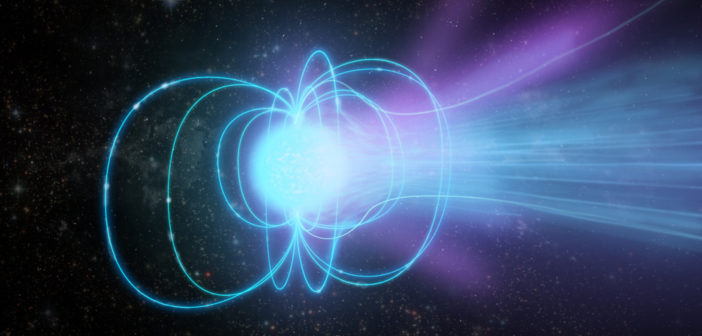On Christmas day in 2010, the Swift Observatory detected gamma rays from a mysterious source for a whopping 28 minutes. More than a decade later, astronomers are still theorizing about the cause of this unusual gamma-ray burst.

Digital rendering of the aftermath of a collision between a neutron star and a red giant, which is one possible explanation for GRB 101225A. [NASA/Goddard Space Flight Center]
An Intriguing Event
GRB 101225A, dubbed the “Christmas burst” because of its holiday debut, has inspired plenty of theories due to its unusually long-duration gamma-ray emission — and its unexpectedly brief, flaring X-ray emission. The proposed causes range from long-distance (a neutron star billions of light-years away being engulfed by a red-giant companion) to local (a neutron star 10,000 light-years away snacking on a comet). Further hypotheses include a collapsing ultra-low-metallicity blue supergiant star or even a never-before-seen class of astrophysical phenomena.
The authors of today’s article put forward a new hypothesis: what if GRB 101225A’s unusual emission comes from something we’ve seen before — but viewed from a different angle?

X-ray and optical afterglow (AG) emission from GRB 101225A (black and orange symbols, respectively) as well as two other events potentially involving off-axis jets (blue and pink symbols). The solid lines show the results of the jet model, while the dashed lines are empirical fits to the data. The x-axis indicates the time since the Burst Alert Telescope (BAT) observations began. Click to enlarge. [Zou et al. 2021]
Modeling Multiwavelength Emission
The motivation for this theory, developed by Le Zou (Guangxi University, China) and collaborators, came from observations of a more recent gamma-ray burst: GRB 170817A. The gravitational-wave signal that preceded this gamma-ray burst indicated that it resulted from two neutron stars colliding, potentially leaving behind a massive newborn magnetar — a neutron star with an extremely strong magnetic field — with a relativistic jet. Further analysis of the event’s multiwavelength emission suggested that the jet was viewed at an angle, potentially as much as a few tens of degrees off center.
Zou and coauthors explored the possibility that GRB 101225A was also caused by a newly formed magnetar with a jet, and its unusual gamma-ray and X-ray signatures arise as a result of our off-axis view.
To test this theory, the team modeled the emission from a relativistic jet colliding with the surrounding interstellar medium and compared their results to the observations. The authors find that the optical data are consistent with the afterglow produced by a narrow jet viewed from just a few degrees off center.
A More Detailed View
The authors suggest that their model also explains the flaring behavior seen in GRB 101225A’s X-ray emission hours after the onset of the event. If GRB 101225A is caused by a magnetar, we should see semi-periodic oscillations in the X-ray flux caused by the precession of the magnetar’s rotation. The team’s X-ray model roughly reproduces the observed flares with periods of 250 and 488 seconds, suggesting that the flaring behavior could be due to the precession of a magnetar.The team’s results are still tentative, and more data could help tease out the cause of this unusual event. Much like the observations of gravitational waves from GRB 170817A enhanced our understanding of that event, so will gravitational-wave observations of future GRB 101225A-like events. The team estimated that current gravitational-wave observatories aren’t sensitive enough to detect a GRB 101225A-like event, but future observatories should be. As we learn more about this varied class of events, we should be able to refine our understanding and put our many theories to the test.
Citation
“GRB 101225A as Orphan Dipole Radiation of a Newborn Magnetar with Precession Rotation in an Off-axis Gamma-ray Burst,” Le Zou et al 2021 ApJL 921 L1. doi:10.3847/2041-8213/ac2ee4


